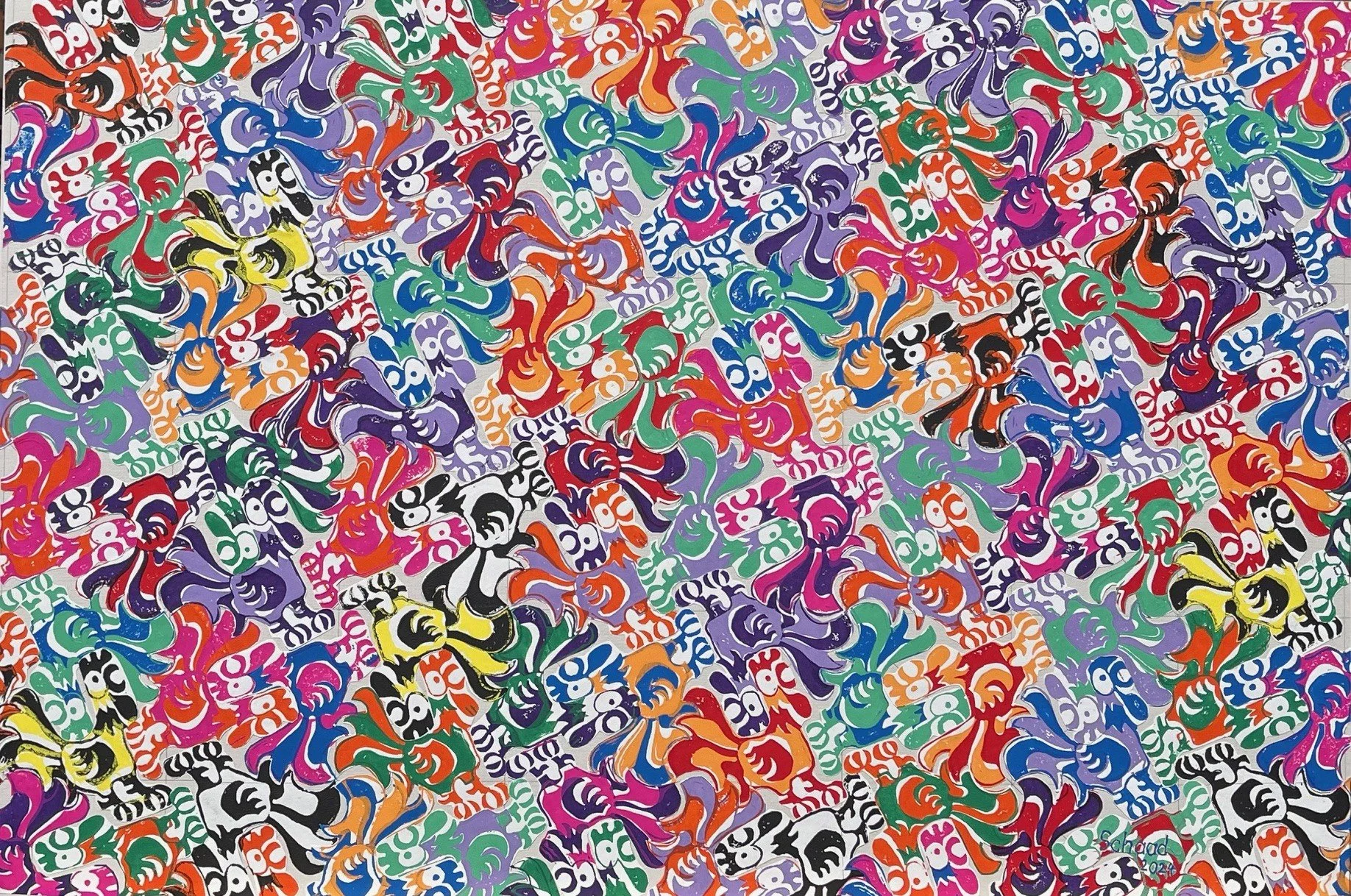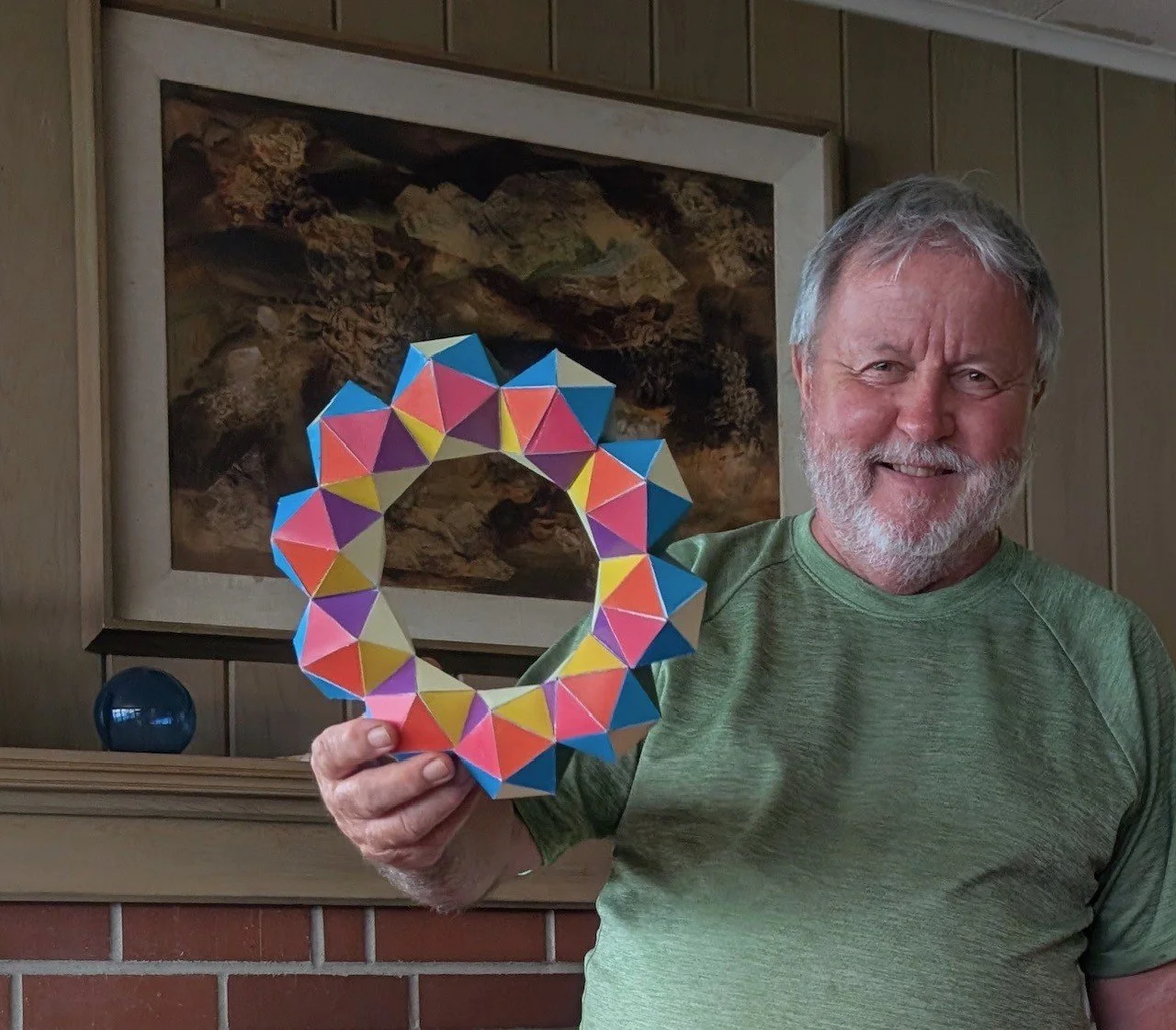The Beauty of Symmetry and Tessellations
Theo Schaad
Physics Department, University of Washington, WA, USA
Published in the JOURNAL OF MATHEMATICS AND THE ARTS, Taylor & Francis Group. https://doi.org/10.1080/17513472.2025.2518518.
Music, art, and physics have played important roles in my life, often in stretches lasting over a decade, sometimes at the exclusion of each other, sometimes with two of them at the expense of the third. But since my early retirement ten years ago, my focus and joy has been with mathematical art, while I maintain my music passion as a violinist in an orchestra and in a string quartet. I keep my physics interests in a committee that organizes public lectures in frontier physics at the University of Washington in Seattle. I think I have found a good balance. There are fascinating connections between music, art, and science, as brilliantly presented in Douglas Hofstadter’s book Goedel, Escher, and Bach. To me, music is my emotional well-being, art is my creativity, and physics is my quest to understand the universe and make a living.
I was born in Zürich, Switzerland, in the academic neighborhood of the city. My father was a teacher and a polymath himself. He played the organ in church and listened endlessly to the music of J.S. Bach. He wrote books about the local geography and history, richly illustrated with ink drawings. I started playing the piano when I was six years old. I learned to play from sheet music even before I could read. When I was nine years old, I switched to the violin. In Switzerland, the educational path was split in the seventh grade. While I could have easily succeeded with the university-bound curriculum, my father wanted me to follow his career in a teaching seminary. The school had an emphasis on art and music, and I played a lot of piano, organ, and violin in my teenage years. At eighteen, I enrolled in an exchange student program and lived in Seattle for a year. I joined the Seattle Youth Symphony Orchestra under Villem Sokol and was part of a memorable performance of Gustav Mahler’s tenth symphony.
My love for geometry also started at a young age. One poignant memory is laying awake in a Swiss mountain chalet and staring at the old wallpaper. I was simply mesmerized by an intricate floral pattern that seemed to repeat endlessly. For two years at the teaching seminary, we had a great art teacher. Her name was Ruth von Fischer and her specialty was making quilts and wall hangings with larger groups. She taught me to make multi-colored prints from carved linoleum blocks. Many years later, this turned out to be my preferred way to make tessellations. I taught elementary school for a year in Eglisau, Switzerland. I made jumbled sketches that could be solved with a color code that was the answer to arithmetic equations. To fool the students, I made one with interlocking animals, which was my entry into Escheresque drawings, even before I knew about M.C. Escher.
My academic career started in 1975 at the University of Washington in Seattle. My first physics professor was Robert Ingalls. I had no idea that we would share years later a common interest in playing classical music together and making quasiperiodic tilings. He helped me enroll as a physics major. He also introduced me to Hermann Weyl’s book on symmetry, which describes mathematical insights into nature and art. Of course, I made my own set of the seventeen wallpaper patterns. Martin Gardner published the fivefold quasiperiodic pattern of Roger Penrose in the January 1977 edition of the Scientific American. I tried to improve Penrose’s version of interlocking Escheresque chicken. The result may not convince everyone, but the art piece is still hanging in one of the entrances of the physics building at the University of Washington. In 1979, I independently discovered the quasiperiodic octagonal tiling that was later named Ammann-Beenker. I showed it to Branko Grünbaum, a math professor at our university. I am not sure he remembered it when he published his now standard textbook on Tilings and Patterns.
I was completely consumed by physics in graduate school at Harvard University. I spent four years at the Stanford Linear Accelerator Center where I wrote my PhD thesis on a property of subatomic particles that contain b quarks. I then relocated to Switzerland for three years where I had a post-doctoral appointment at the University of Geneva and at CERN. In 1988, we decided to raise our family in Seattle. I found a job in a company that made high precision pressure sensors, and I developed a seismic sensor that was deployed in Japan for tsunami warning.
It has now been another decade since I took an early retirement. Finally, I have had all the time needed to pursue my passion in tessellations. I published a paper on arXiv on sixfold quasiperiodic tilings (Schaad, 2016). During the pandemic I studied sevenfold and twelvefold tilings. I discovered that a Swiss mathematician had discovered similar examples. We started communicating by email and have co-authored three more papers (Stampfli and Schaad, 2021; 2022). Peter Stampfli introduced me to the Bridges Conference on Mathematical Art. I not only met him at the Helsinki Conference in 2022, I discovered a whole tribe of artists and mathematicians that share similar interests (Schaad, 2022). My new connections enabled me to add my novel seven-fold tessellation to the Bielefeld tiling encyclopedia.
The Rooster tessellation that I include here was made in 2024 with block prints that date to 1979. Originally, I made a two-color linoleum print with only one rooster. Later, I discovered that it would fit into a periodic tessellation with minor modifications. I then carved two blocks with eight interlocking roosters. The colors are reversed in four of them. With only two colors, it is somewhat difficult to spot the individual roosters, so I made about two dozen prints in various colors and cut the individual animals out. I then rearranged them into a collage. The tessellation is a fourfold periodic tiling in one of the wallpaper patterns, specifically the p4 (442) pattern. The numbers in the parenthesis indicate that there are two fourfold and one twofold rotational symmetries. If you study the collage, you should be able to find these places. You can also find roosters in opposite colors stemming from the same block print that had eight roosters. The collage is a mix of mathematics and art. The pattern can be described by a rotational symmetry, but I applied the colors freely and spontaneously, which makes a unique artistic statement. The piece was exhibited at the Joint Mathematics Meeting 2025.
References
T.P. Schaad (2015). 6-fold quasiperiodic tilings with two diamond shapes. arXiv:1503.03018 (math.GM).
T. P. Schaad (2022). Schaad’s 7-fold, D. Frettlöh, F. Gähler, E. Harris: Tilings encyclopedia. https://tilings.math.uni-bielefeld.de/
P. Stampfli, T.P. Schaad (2021). Quasiperiodic tilings with 12-fold rotational symmetry made of squares, equilateral triangles, and rhombi. D. Swart, F. Farris, & E. Torrence (Eds.), Bridges 2021 Conference Proceedings (pp. 315-318). Tessellations Publishing.
P. Stampfli, T. P. Schaad (2022). Ptolemy, the regular heptagon, and quasiperiodic tilings. D. Reimann, D. Norton, & E. Torrence (Eds.), Bridges 2022 conference proceedings (pp. 135-142). Tessellations Publishing.



